Summer Institute in Rome
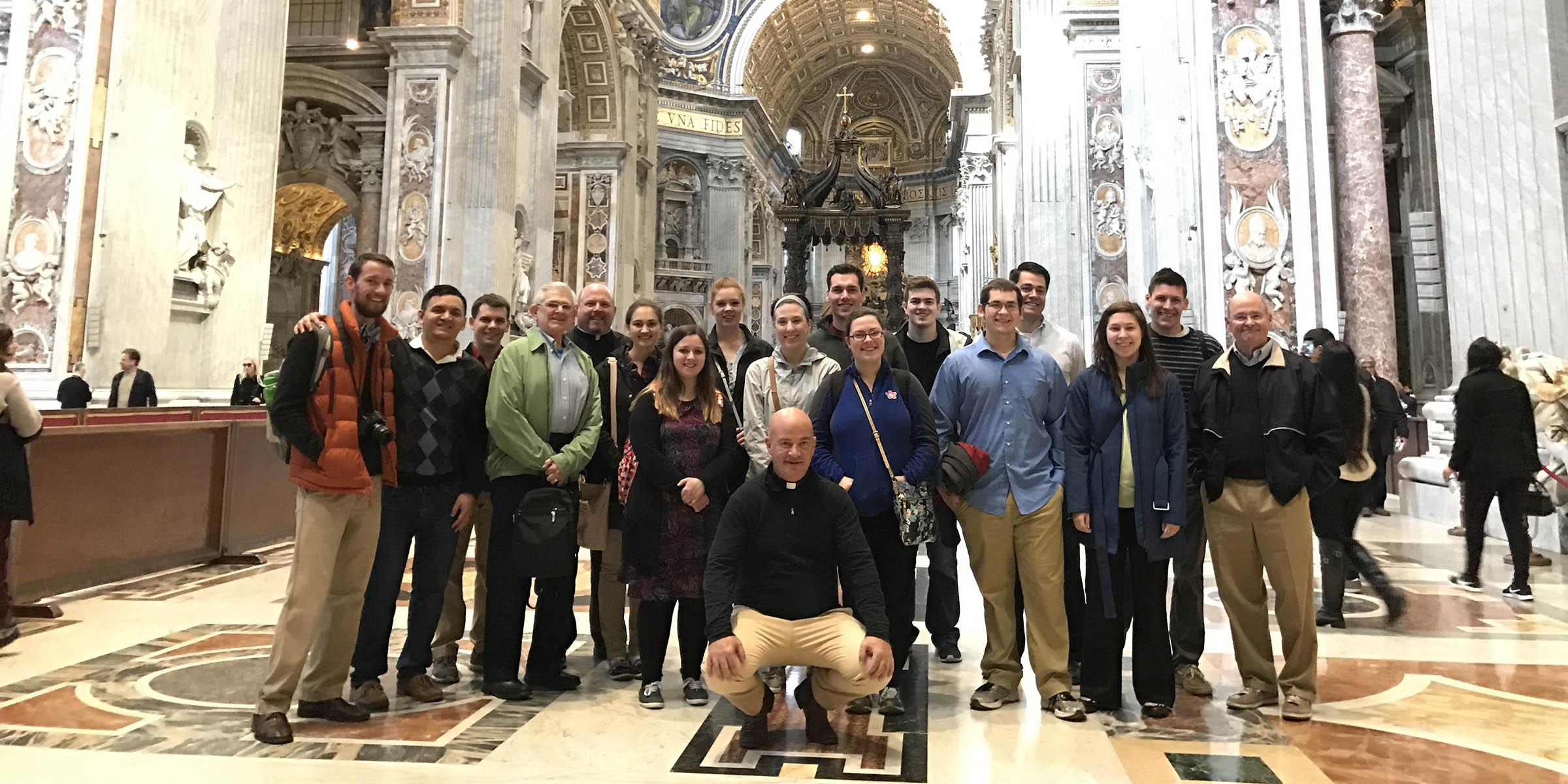
-
In This Section
Spend Your Summer In Rome
There's a new road that leads from Saint Vincent College to Rome!
Saint Vincent College students and interested students from other colleges and universities are invited to apply to be part of the annual SVC Summer Institute in Rome. Sponsored by the Saint Vincent Center for Catholic Thought and Culture, this once-in-a-lifetime trip offers an unforgettable experience.
- Live in the historic Benedictine monastery, Sant'Anselmo, atop the famous Aventine Hill.
- Study in SVC Core courses with your friends.
- Explore Rome's cobblestone streets, lively markets, and iconic ruins.
- Savor some of the finest food the world has to offer (including cappuccinos and gelati).
- Marvel at the history, both secular and sacred, that is intertwined with nearly every street.
- Grow as a student and person as you are nourished by the great ideas, art, and faith that have made Rome the center and heart of Western Civilization.
As a student in the Summer Institute in Rome, you’ll spend five weeks exploring the city and surrounding areas and experiencing Italian culture and heritage. You will also fulfill two Core courses in one of the world’s most historically significant cities and one very much still at the center of the Catholic intellectual tradition. For students outside of Saint Vincent College, we are willing to work with your institution so that you may receive college credit for our unique courses in the Eternal City. After these five weeks, you will know your way around Rome, and feel that it is, at least in part, your city!
Loving Rome
Sant'Anselmo all'Aventino
Students who attend the SVC Summer institute in Rome will live in a guest wing of Sant'Anselmo monastery atop the historic Aventine Hill. Sant'Anselmo is home to an International College and is the Primatial Abbey of the Order of Saint Benedict where monks from around the world stay when they are studying in Rome, making it an incredibly diverse and culturally rich religious house. Students will have the opportunity to attend daily prayer, mass, and confession.
Nestled in a quiet and safe residential neighborhood, Sant'Anselmo is an easy walk to all the famous places in Rome. It is just south of the Circus Maximus, the ancient Roman Forum, and the iconic Colosseum. Come and live in Rome for five weeks and experience the beauty of the Aventine Hill and the peaceful setting of Sant'Anselmo.
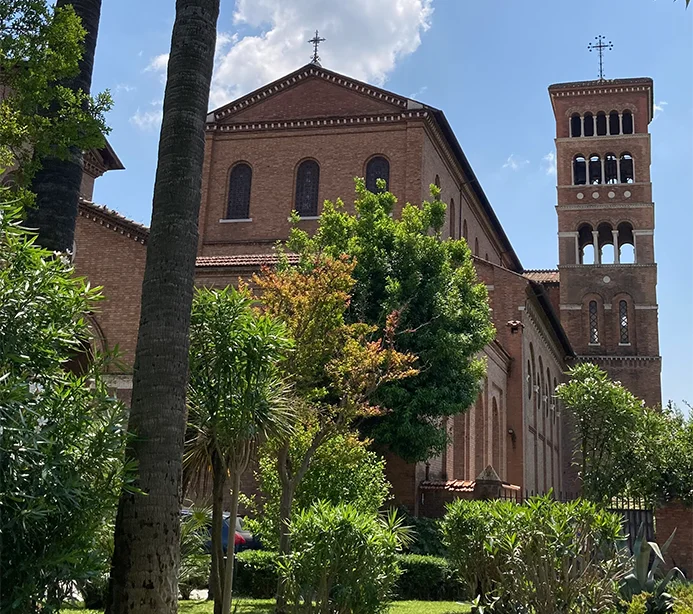
Nourishment for body and spirit
Roman cuisine is fresh, seasonal, and simply prepared. Most of your meals will be at Sant'Anselmo with the monks, but we will also eat weekly at local, family-owned restaurants. Wine is typically served at both lunch and dinner and is meant to compliment the meal. As part of the cultural experience, the SVC Summer Institute will host a sommelier to provide you with a basic knowledge of Italian wines.
While most meals are included in the cost of attending the Summer Institute, you will have a few opportunities to explore the city restaurants on your own. Street vendors offer grab-n-go sandwiches and refreshments and for those with a sweet tooth, prepare to see gelato and cappuccino around every cobblestoned corner. Come to Rome with an open mind and a desire to extend your palate!
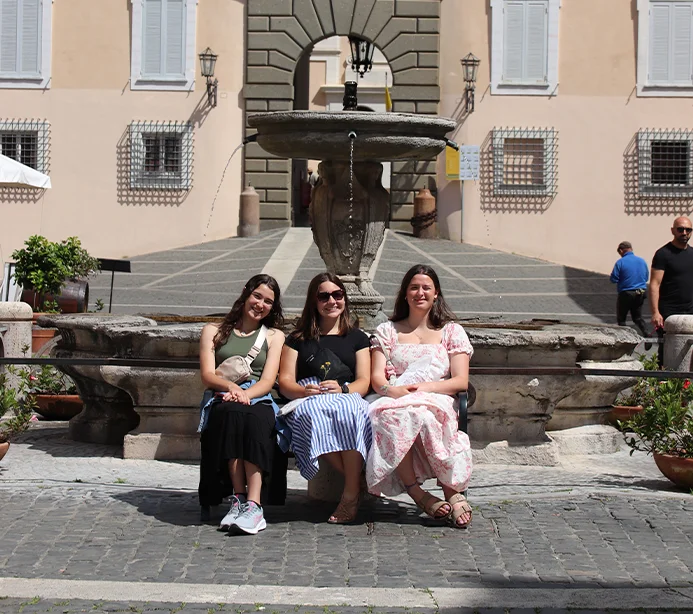
Live like a Roman
The SVC Summer Institute in Rome allows students to experience Rome firsthand. As a student in the Eternal City, you will find that Roman culture is more than ancient artifacts. Rome is a modern city that celebrates the past and has preserved the traditions from multiple generations.
The historic Castel Sant'Angelo is a good example of what you will find in Rome. Originally built as a tomb for the Emperor Hadrian and later turned into a fortress to protect the Pope during invasions, today it is a museum with a modern restaurant at its top. Imagine sitting atop 2,000 years of history, with St. Peter’s Basilica to your right and Baroque sculptures by Bernini adorning the bridge below—all while sipping a cappuccino and chatting with friends.
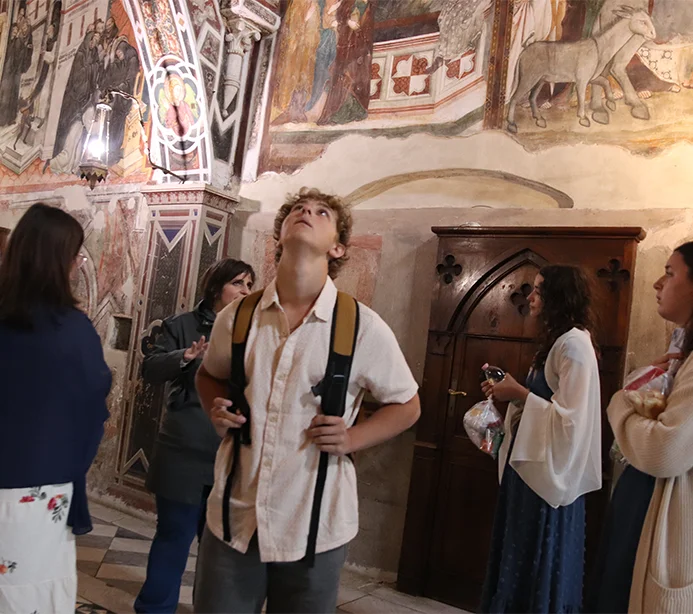
Explore beyond Rome
Although the Eternal City has much to offer, you will have the opportunity to see more of Italy. We’ll spend a weekend in Florence, exploring its Renaissance art, architecture, and monuments including the Santa Maria del Fiore, Palazzo Vecchio, and Ponte Vecchio. Along with viewing the Christian art in Florentine museums and churches, and seeing Galileo's telescope, there will also be time for you and your friends to explore the city on your own.
Students will also take day trips to Benedictine and Catholic heritage sites like Subiaco, Monte Cassino, and Assisi. With at least a couple of free weekends, you'll have time to explore more of Rome or travel elsewhere in Italy—and we’ll help you navigate public transportation so the Eternal City truly feels like home.
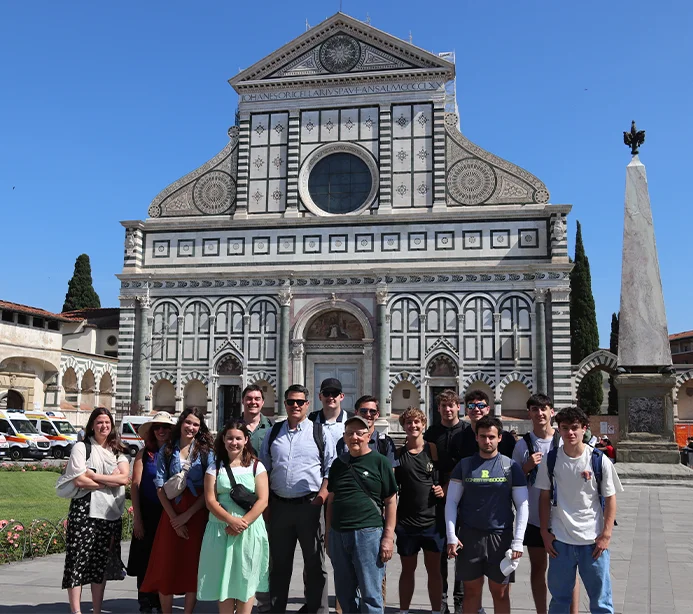
A life-changing experience within reach
The SVC Summer Institute in Rome is an excellent opportunity to learn and live in Rome! Our goal is to make this experience as affordable as we can.
In addition to regular SVC summer tuition costs and airfare, the cost for the trip is a $3500 fee (housing, group travel in Italy, and all group meals). Pell grants are applicable to tuition costs.
Saint Vincent College students only: We understand every student’s situation is unique, which is why we offer additional need-based scholarships to help reduce program costs. Admitted students may apply for further funding, with priority given to full-time Saint Vincent students.
If you have any questions about need-based or tuition scholarships, contact SIIR Director Dr. Jerome Foss (jerome.foss@stvincent.edu) or Jody Marsh (jody.marsh@stvincent.edu).
You may also send questions to cctc@stvincent.edu.

-

Students who attend the SVC Summer institute in Rome will live in a guest wing of Sant'Anselmo monastery atop the historic Aventine Hill. Sant'Anselmo is home to an International College and is the Primatial Abbey of the Order of Saint Benedict where monks from around the world stay when they are studying in Rome, making it an incredibly diverse and culturally rich religious house. Students will have the opportunity to attend daily prayer, mass, and confession.
Nestled in a quiet and safe residential neighborhood, Sant'Anselmo is an easy walk to all the famous places in Rome. It is just south of the Circus Maximus, the ancient Roman Forum, and the iconic Colosseum. Come and live in Rome for five weeks and experience the beauty of the Aventine Hill and the peaceful setting of Sant'Anselmo.
-

Roman cuisine is fresh, seasonal, and simply prepared. Most of your meals will be at Sant'Anselmo with the monks, but we will also eat weekly at local, family-owned restaurants. Wine is typically served at both lunch and dinner and is meant to compliment the meal. As part of the cultural experience, the SVC Summer Institute will host a sommelier to provide you with a basic knowledge of Italian wines.
While most meals are included in the cost of attending the Summer Institute, you will have a few opportunities to explore the city restaurants on your own. Street vendors offer grab-n-go sandwiches and refreshments and for those with a sweet tooth, prepare to see gelato and cappuccino around every cobblestoned corner. Come to Rome with an open mind and a desire to extend your palate!
-

The SVC Summer Institute in Rome allows students to experience Rome firsthand. As a student in the Eternal City, you will find that Roman culture is more than ancient artifacts. Rome is a modern city that celebrates the past and has preserved the traditions from multiple generations.
The historic Castel Sant'Angelo is a good example of what you will find in Rome. Originally built as a tomb for the Emperor Hadrian and later turned into a fortress to protect the Pope during invasions, today it is a museum with a modern restaurant at its top. Imagine sitting atop 2,000 years of history, with St. Peter’s Basilica to your right and Baroque sculptures by Bernini adorning the bridge below—all while sipping a cappuccino and chatting with friends.
-

Although the Eternal City has much to offer, you will have the opportunity to see more of Italy. We’ll spend a weekend in Florence, exploring its Renaissance art, architecture, and monuments including the Santa Maria del Fiore, Palazzo Vecchio, and Ponte Vecchio. Along with viewing the Christian art in Florentine museums and churches, and seeing Galileo's telescope, there will also be time for you and your friends to explore the city on your own.
Students will also take day trips to Benedictine and Catholic heritage sites like Subiaco, Monte Cassino, and Assisi. With at least a couple of free weekends, you'll have time to explore more of Rome or travel elsewhere in Italy—and we’ll help you navigate public transportation so the Eternal City truly feels like home.
-

The SVC Summer Institute in Rome is an excellent opportunity to learn and live in Rome! Our goal is to make this experience as affordable as we can.
In addition to regular SVC summer tuition costs and airfare, the cost for the trip is a $3500 fee (housing, group travel in Italy, and all group meals). Pell grants are applicable to tuition costs.
Saint Vincent College students only: We understand every student’s situation is unique, which is why we offer additional need-based scholarships to help reduce program costs. Admitted students may apply for further funding, with priority given to full-time Saint Vincent students.
If you have any questions about need-based or tuition scholarships, contact SIIR Director Dr. Jerome Foss (jerome.foss@stvincent.edu) or Jody Marsh (jody.marsh@stvincent.edu).
You may also send questions to cctc@stvincent.edu.
Learning in Rome
Liberal Education in the Eternal City
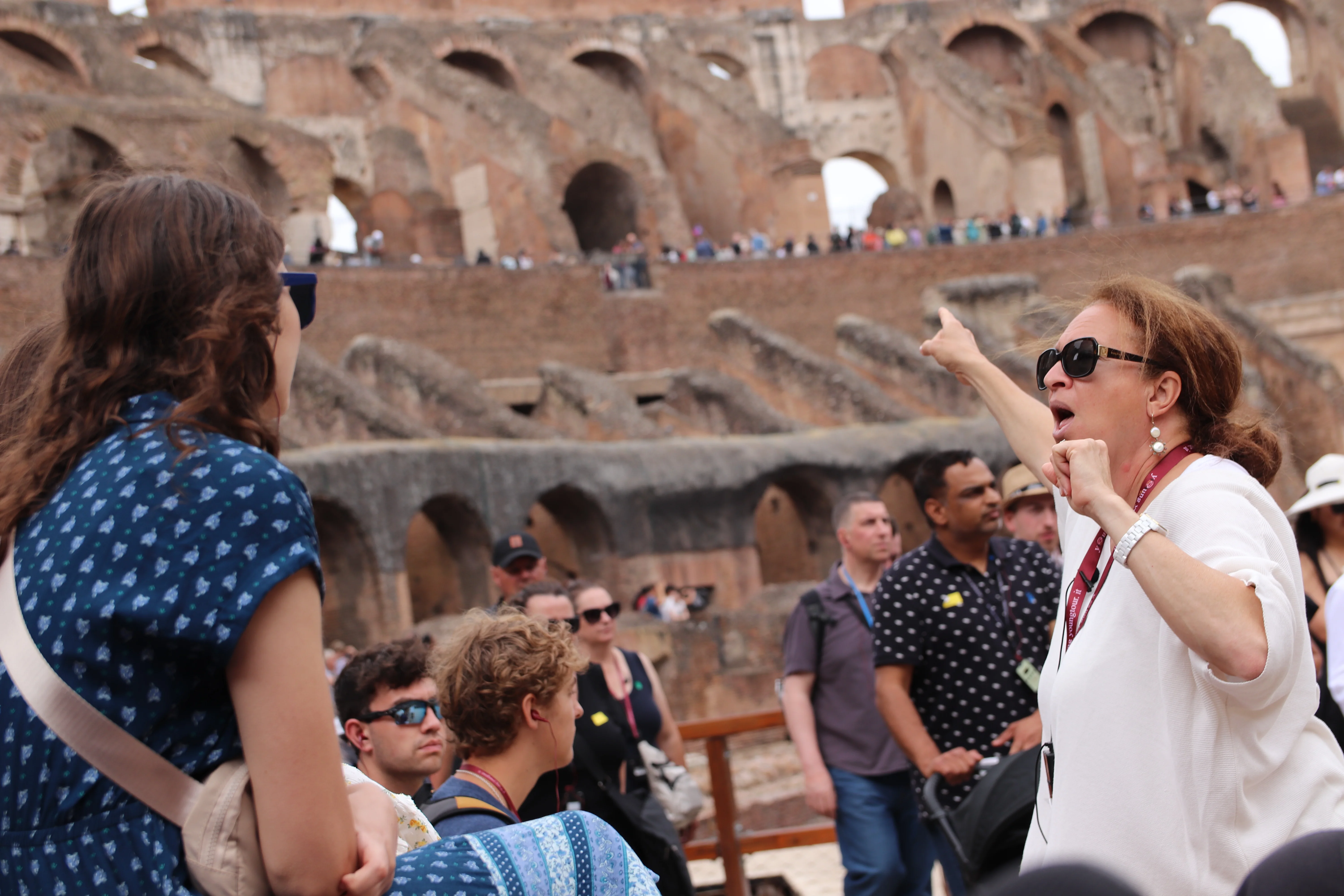 The Summer Institute in Rome is open to all SVC students as well as students from other colleges and universities. The SIIR program allows all students to complete required coursework during an accelerated semester in Rome.
The Summer Institute in Rome is open to all SVC students as well as students from other colleges and universities. The SIIR program allows all students to complete required coursework during an accelerated semester in Rome.
All of the courses fulfill the SVC Core Curriculum requirements. For students outside SVC, we will help you negotiate transfer credits for our courses with your institution. We have classroom space at Sant'Anselmo, but much of our course time will be spent in museums, churches, and historic sites. We will also travel as a class to Florence, learning how its politics, art, and science drew inspiration from Rome. Other trips include Assisi, Subiaco, and Monte Cassino.
Explore the tabs below for more information about the courses that are being offered.
-
Roman Political Thought
Ancient Rome’s contributions to civilization are legion. Among the most visible are the ideas and practices that continue to influence the political philosophy and civil and legal institutions of many nations, including the United States. This course seeks to understand the Roman conceptions of such things as statesmanship, law, citizenship, virtue, rhetoric, civil religion, and imperialism, through a close reading of primary sources written by those who shaped or later reflected upon Rome. Authors might include Cicero, Lucretius, Livy, Virgil, Tacitus, Marcus Aurelius, Plutarch, St. Augustine, Machiavelli, Shakespeare, Gibbon, and Publius.
This course can be taken as either a politics or a philosophy course, thus fulfilling either a social science or a philosophy core requirement. Three credits.
The course professor is Dr. Jerome Foss, associate professor of politics, Director of the Saint Vincent Center for Catholic Thought and Culture, Director of the SVC Summer Institute in Rome, and Fellow of the Center for Political and Economic Thought. Dr. Foss earned his B.A. from the University of Dallas and his M.A. and PhD from Baylor University. He has published several articles and two books: Flannery O'Connor and the Perils of Governing by Tenderness (Lexingtong, 2019) and Constitutional Democracy and Judicial Supremacy: John Rawls and the Transformation of American Politics (Cambria, 2016).
-
Images and Evangelization - Christian Art in the City of Rome
This class explores the city of Rome as the cradle of the Christian tradition in the visual arts. From the earliest paintings in the catacombs to the monumental installations of the Baroque, the Christian community in Rome engaged with the arts as a form of evangelization. While at first, art was strictly tied to theology, the Middle Ages saw art collaborate more closely with the imagination of the artist culminating in the glorious productions of the Renaissance and the Baroque. Through readings, site visits and classroom lectures, students will learn the history of Christian imagery in Rome, the techniques and methods for making art, the rudiments of iconography, and also explore the question of defining "Christian" Art. Site visits will include the Catacombs of Priscilla, the Sistine Chapel, St Peter's Basilica, St Mary Major, as well as a trip to Florence.
This course will fulfill students' fine arts requirement for the core. Three credits.Dr. Elizabeth Lev is an American-born art historian who lives and studies art in Rome. She graduated from the University of Chicago in 1989 and earned her graduate degree from the University of Bologna in Northern Italy. She is the author of three books and has published numerous articles for First Things, Sacerdos, and Inside the Vatican magazines, the College Art Association, and Zenit News Agency.
-
Galileo and the Rise of Modern Science
The Italian scientist Galileo Galilei is called the father of modern science, for his numerous contributions to astronomy, physics, instrumentation, methodology, and the philosophy of science. He is a central character in the development of a dramatic new view of the universe that emerged in the 16th and 17th centuries. Galileo’s discoveries and opinions made him a celebrity, but he was also perceived as challenging long-established scientific and philosophical truths. Opposition to Galileo grew until he was finally put on trial by the Inquisition in 1633, for suspicion of spreading heresy with his scientific ideas.
What were Galileo’s discoveries? Why did his work draw both high praise and deep criticism? Why did a Pope who initially admired Galileo and his work eventually put his friend on trial for heresy?
What have been the scientific and religious repercussions of the Galileo affair for the past four centuries?
We will explore these questions in Italy, where Galileo spent his entire life. We will visit the most significant sites of the Galileo affair in Rome, all within easy reach from our classroom at Sant’Anselmo. We will also visit Florence, the city Galileo called home.
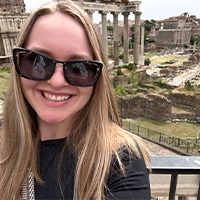
“The summer institute program gave me an experience of a lifetime that I will forever cherish. Since I've never travelled internationally, I enjoyed that we were able to travel as a group so I could just focus on enjoying my trip and classes. Sant Anselmo was perfect for getting around because we could walk everywhere or just hop on the metro when we had free time. The professors were great too, bringing us gelato or coffee or showing us a new hike route to get back to Sant Anselmo.”
Lucy Brayton, C'26
Contact Information
Please do not hesitate to contact us with any questions. We are here for you!
Email the Center for Catholic Thought and Culture or any of the following:
Jerome C. Foss, Ph.D.
Associate Professor of Politics; Director, The Saint Vincent Center for Catholic Thought and Culture;
Director, The SVC Summer Institute in Rome
jerome.foss@stvincent.edu
724-805-2652
Samantha Firestone
Coordinator, The Saint Vincent Center for Catholic Thought and Culture
Coordinator, The SVC Summer Institute in Rome
samantha.firestone@stvincent.edu
